Planting trees and hedges
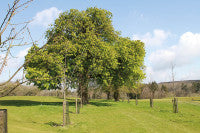 I can remember my first experiences of planting trees on a large scale. It was back in 1973 when I was a parks apprentice with Birmingham City Council. The Government had come up with a scheme to "Plant A Tree In '73", which was followed by "Plant Some More In '74". I must have planted thousands in and around the city's parks in those two years, from small whips to full, root ball, 12ft high specimens. Nearly forty years later, I am able to look back at the fully grown specimens with some pride
I can remember my first experiences of planting trees on a large scale. It was back in 1973 when I was a parks apprentice with Birmingham City Council. The Government had come up with a scheme to "Plant A Tree In '73", which was followed by "Plant Some More In '74". I must have planted thousands in and around the city's parks in those two years, from small whips to full, root ball, 12ft high specimens. Nearly forty years later, I am able to look back at the fully grown specimens with some pride
Laurence Gale MSc doesn't beat about the bush!
Planting trees and hedges should not be looked at in terms of being a chore, a 'bang' em in' exercise, or that it may be too expensive. Planting trees and hedges is about leaving a lasting legacy for future generations to enjoy and benefit from.
Even today, more than two centuries after their death, we admire the achievements of landscape gardeners such as Capability Brown and Thomas Archer, such is their legacy.
Many factors must be taken in to consideration when planting trees and hedges. First of all, and prior to any planting, think carefully what you are trying to achieve:
- Screening
- Wind break
- Noise barrier
- Demarcation of perimeters
- Decorative and/or ornamental
- To control livestock
- To control soil erosion
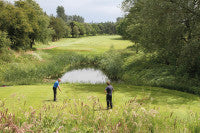 The choice of planting material will need to be carefully considered. Should it be a single species, deciduous or evergreen, or a mixture? Should they be flowering or non flowering, thorny or smooth barked?
The choice of planting material will need to be carefully considered. Should it be a single species, deciduous or evergreen, or a mixture? Should they be flowering or non flowering, thorny or smooth barked?
It is also important to choose the right plant for the right place; the topography and environmental factors of the site will dictate what can be planted and where.
- Ground conditions; is it wet, dry, free draining? Can the selected species thrive in the local soil?
- Height; will the tree have the chance to mature?
- Canopy spread; how wide will the tree grow?
- Is the tree deciduous or coniferous? Will leaf drop be a factor in the winter?
- Form or shape. A columnar tree will grow in less space. Round and V-shaped species provide the most shade
- Growth rate; how long will it take for your tree to reach its full height? Slow growing species typically live longer than fast growing species
- Soil, sun, and moisture requirements
- Access for maintenance
The condition and age of the plant material is vitally important in terms of dictating both the successful establishment and how quickly you want the hedge or tree to achieve its objective.
 There have been, over the years, many schools of thought on what is the best stock size to plant for quick establishment - whips, half standards, standards or large root ball. It would seem that one of the most cost effective and successful methods is planting young stock material (whips) 30-90cm in height. They are quick and easy to plant and tend to have a better establishment rate.
There have been, over the years, many schools of thought on what is the best stock size to plant for quick establishment - whips, half standards, standards or large root ball. It would seem that one of the most cost effective and successful methods is planting young stock material (whips) 30-90cm in height. They are quick and easy to plant and tend to have a better establishment rate.
If you wish to create a hedge which is really dense and bushy from the ground upwards, it is advisable to plant young, small plants. Within two to three years you will have a good hedge, especially if you have prepared the ground well and used feeds, manure and/or bio stimulants.
However, sometimes you may need to see a more instant result using larger containerised plants.
Containerised plants have only been in commercial existence since the mid 1970s. Prior to that, most stock was bare root, which was traditionally only ever planted during the winter months (November -March).
However, today, with so much more user friendly accessories available to aid planting when excavating, staking, feeding and watering, the job of hedge and tree planting has been made much easier and more flexible.
Also, the array of machinery now on offer to aid planting and cultivation is immense; rotavators, trenchers and small diggers are relative cheap and, in most cases, may be hired. We have also seen the introduction of tree spades that are able to remove and replant large trees.
Always source material from reliable nurseries and ensure it is true to cultivar/species and in good health. In recent years, a lot of imported nursery stock has been blighted with disease; the recent ash die back disease being a prime example. This has affected the supply of many trees in the UK in recent months, with nurseries having to dispose and burn their stocks to prevent its spread.
 Getting your plants ready
Getting your plants ready
Ensure you are ready for your plants, as they deteriorate if left in their packing too long. If you are not able to plant them immediately, ensure you have an area of cultivated soil in a sheltered site prepared in advance. Do this by digging a trench about 50cm (20 inches) deep and cover the area with polythene to keep it dry and prevent it from freezing. When the plants arrive, unwrap them - any bare-rooted ones should be soaked for up to two hours in water. Bed the plants into the prepared trench and cover the roots with soil, which should be watered if dry. The plants can remain in this state until you are able to plant into their final place. Any pot grown or containerised plants should be watered, as required, and then kept in a sheltered position until planted.
In many cases, people tend to choose the quickest method and, quite often, end up planting the whip at the back of their spade which, on large planting jobs, has been the norm. It does work, but you may get more plant losses using this method.
Preparing the Ground
Understanding the type of ground conditions is very important. The success of any crop is down to the soil type and the condition of the soil on site. Soils have different properties. Most consist of three key components - clay, silt and sand - with the soil type classified by the total percentage of these materials. The soil triangle will help you identify your soil type.
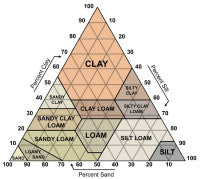 The sides of the soil texture triangle are scaled for the percentages of sand, silt, and clay. Clay percentages are read from left to right across the triangle. Silt is read from the upper right to lower left. Sand from lower right towards the upper left portion of the triangle. The boundaries of the soil texture classes are highlighted in bold lines. The intersection of the three sizes on the triangle give the texture class. For instance, if you have a soil with 20% clay, 60% silt and 20% sand, it falls in the 'silt loam' class.
The sides of the soil texture triangle are scaled for the percentages of sand, silt, and clay. Clay percentages are read from left to right across the triangle. Silt is read from the upper right to lower left. Sand from lower right towards the upper left portion of the triangle. The boundaries of the soil texture classes are highlighted in bold lines. The intersection of the three sizes on the triangle give the texture class. For instance, if you have a soil with 20% clay, 60% silt and 20% sand, it falls in the 'silt loam' class.
The class of soil you have will govern what is required to help the plant survive until it establishes a good root structure. Sandy soils tend to dry out more readily and will need watering. A heavy clay soil will retain water. Your soil classification and the dominant parent material, for example clay or limestone, will also determine soil pH. Soil type and pH will also help to determine which plants are best suited for your site.
If possible, get the preparation done before the winter planting season - whilst the weather and soil is still warm. Irrigate dry soils copiously before any cultivation is carried out.
Species chosen for the hedge should be representative of hedgerows in the surrounding area. Use of local native plant species is best, wherever possible, as this will provide food and habitat for wildlife, and are generally safer for livestock. When planting native species, ensure they have come from British grown stock. The hedgerow scheme will need to include details of how many of each species are to be planted.
 Typical Rural Hedgerow Species Mix
Typical Rural Hedgerow Species Mix
Main Matrix (Transplants/Quicks)
70% of planting stock
Hawthorn (Crataegus monogyna)
Blackthorn (Prunus spinosa)
Interplant (Whips/Transplants)
30% of planting stock
Hazel (Corylus avellana)
Holly (Ilex aquifolium)
Dog Rose (Rosa canina)
Field Maple (Acer campestre)
Dogwood (Cornus sanguinea)
Spindle (Euonymous europaeus)
Wild Privet (Ligustrum vulgare)
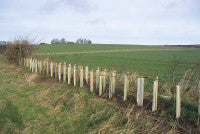 Hedging should be planted in two staggered rows at a density of not less than five per metre, with approximately 450mm between plants in the same row, and 300-400mm between rows. The interplant whips/transplants should be planted within this pattern in groups of two or three. The density of planting and distances between plants should be specified in the hedgerow scheme
Hedging should be planted in two staggered rows at a density of not less than five per metre, with approximately 450mm between plants in the same row, and 300-400mm between rows. The interplant whips/transplants should be planted within this pattern in groups of two or three. The density of planting and distances between plants should be specified in the hedgerow scheme
To improve the structure of the soil, incorporate generous quantities of compost, such as well-rotted garden compost, well-rotted farmyard manure, mushroom compost or composted bark. If the soil has poor drainage, add sharp sand or coarse grit (make sure it is lime-free). If the soil is heavy clay, take care not to create a solid basin at the base of the trench that will stop the water from draining freely.
If this preparation is carried out in advance of planting, the soil can then settle and will be workable when the time comes to plant during winter. Even if the soil is cold and frosty on the surface, it will be relatively easy to turn over if it has been correctly prepared.
Plant the new plants and mulch well with at least 5-10cm (2-4in) bark chips or other mulching material around the plants. Put down a landscape fabric first and plant through this, mulching on top. The mulch is very important, as it suppresses weed growth and helps retain valuable moisture in the surrounding soil.
 It is essential that all evergreens are sheltered from drying winds during their first winter and growing season. If the weather conditions are particularly severe, or the site is subject to strong prevailing winds, a protective windbreak should be erected, for example windbreak netting This will help to prevent the plants drying out before their roots are established.
It is essential that all evergreens are sheltered from drying winds during their first winter and growing season. If the weather conditions are particularly severe, or the site is subject to strong prevailing winds, a protective windbreak should be erected, for example windbreak netting This will help to prevent the plants drying out before their roots are established.
For all plants, it is essential that they are kept well watered during their first year, even in winter when they are dormant. It is important to keep them moist in March, April and May just before they break dormancy. As a guide, in dry weather at least two gallons (10 litres) of water per square yard/metre should be applied twice a week. Also, it is advisable to spray over the foliage of evergreens in the evenings as well as watering. Use a hose-end diluter to make the task easier.
Tree and hedge aftercare
Ensure that all tree ties are kept secure but not too tight, and that no grass or weeds are allowed to grow around the plants for at least a year. Invest in good robust materials and choose the best means to secure and protect your hedge and trees.
There are several methods for staking trees depending on their size - single, double and triple staking, short stakes, and cages. For hedges, which may need protection from rabbits and the wind, there are an array of products to choose from. The success of any planting scheme is often determined by how well they have been protected and maintained.
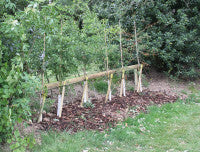 Ensure you buy quality rubber tree ties, webbing, belts and buckles. There are a number of biodegradable tree shelters, tree mats and guards that help protect whips. There are number of different techniques for securing large trees using guy ropes and undersoil ties. However, a correct feeding and watering programme will be the essential aid for their establishment.
Ensure you buy quality rubber tree ties, webbing, belts and buckles. There are a number of biodegradable tree shelters, tree mats and guards that help protect whips. There are number of different techniques for securing large trees using guy ropes and undersoil ties. However, a correct feeding and watering programme will be the essential aid for their establishment.
In the first year, plants often come into leaf and flower much later than established plants, and it should not be assumed that the plants have failed should they be late into leaf. Evergreen shrubs may drop their leaves when transplanted, but they should regrow new shoots within three months of planting.
Whether planting bare root, ball root or pot grown plants, it will pay dividends to invest in growth promoters. In recent years, mycorrhiza products, such as Growaway and Myco Complete, have been widely used to help establish plantings. You may have to invest more money but, in the long term, the benefits outweigh the costs.
Aftercare should not be forgotten. Regularly inspect your plantations, hedges and trees. Set yourself up with a long term maintenance plan. The first ten years are crucial and you will be surprised how quickly time passes by.
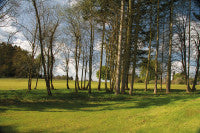 When planting and caring for a new hedge, it is very important to follow the specific pruning and planting instructions provided with the plants. Some people either do not like to cut their hedging plants back, or simply forget to do so. With many varieties, this will result in a hedge which is not dense at the base. The best hedges develop from a good basal regrowth, so ensure pruning is carried out as detailed.
When planting and caring for a new hedge, it is very important to follow the specific pruning and planting instructions provided with the plants. Some people either do not like to cut their hedging plants back, or simply forget to do so. With many varieties, this will result in a hedge which is not dense at the base. The best hedges develop from a good basal regrowth, so ensure pruning is carried out as detailed.
Gap up and replace any dead material, keep weeds down with an assortment of strategies, hand weeding, chemical control and grazing. Do not let the hedge get out of hand, regular cutting will ensure it remains in good condition and achieves its overall aim.
